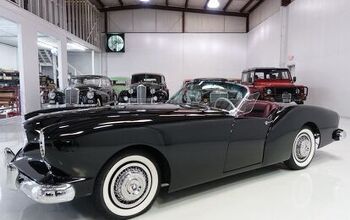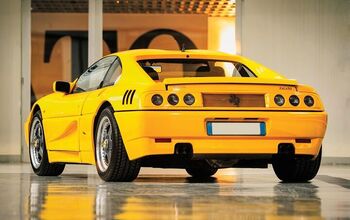Rare Rides: A Very Rare Bizzarrini Strada From 1967

If the Bizzarrini name seems familiar, it’s because we previously learned about one of the very last designs to wear the name: the BZ 2001. In contrast to that failed Nineties project, today’s Rare Ride was Bizzarrini’s most successful commercial offering.
It’s the Strada, from 1967.
While Giotto Bizzarrini did some of the design work for the BZ 2001, in the 1960s he ran a fully functioning car company that bore his name. With a background in racing cars, Bizzarrini was chief engineer at Ferrari by the time he was 32. Shortly thereafter he was fired from Ferrari, and started working for Iso Rivolta as a designer. However, after finishing a few designs, he ended up in an important disagreement.
Company owner Renzo Rivolta wanted to build luxurious GT cars. Mr. Bizzarrini saw things differently, and wanted to stay with his passion and develop race cars. Irreconcilable differences ended their relationship, and Bizzarrini founded his new car company in 1964.
Staying focused on his personal interests, Bizzarrini’s company spent most its time developing and building race cars. It funded its ventures by making road-going versions of said race cars for the well-heeled. The most well-known of Bizzarrini’s very small product line was the Strada.
Bertone was hired to design the car’s incredibly low-slung aluminum body, which boasted an overall height of just 44.1 inches. Developed with a front-mid engine layout, the Strada was powered by a small-block 327 V8 (5.4L) borrowed from a Corvette. In standard consumer guise it made between 365 and 385 horsepower, but power jumped to an even 400 horses in the Corsa. Top speed was 174 miles an hour in early versions.
The Strada entered production in 1964, in time for racing at Le Mans in 1965. After a respectable ninth place overall finish that year, Bizzarrini continued to make refinements to his flagship car. Eventually, the Corvette 327 was swapped in favor of the big block Chevrolet 427 (7.0L). No word on how many of those exist.
There were three versions of Strada: coupe, targa, and the race-ready Corsa. In a total production of 133 cars, just two were targas. A one-off convertible was also produced but remained a prototype. The Strada remained in production through 1968, joined by a couple other Bizzarrini models with much lower production figures. By 1969, however, the small company found itself bankrupt, never to be revived.
Mr. Bizzarrini lives on today.
Today’s Rare Ride was subject to a three-year restoration in Germany, which altered the standard engine to Corsa spec for 400 horsepower. With 32 miles since its restoration, it’s priced upon request.
[Images: seller]

Interested in lots of cars and their various historical contexts. Started writing articles for TTAC in late 2016, when my first posts were QOTDs. From there I started a few new series like Rare Rides, Buy/Drive/Burn, Abandoned History, and most recently Rare Rides Icons. Operating from a home base in Cincinnati, Ohio, a relative auto journalist dead zone. Many of my articles are prompted by something I'll see on social media that sparks my interest and causes me to research. Finding articles and information from the early days of the internet and beyond that covers the little details lost to time: trim packages, color and wheel choices, interior fabrics. Beyond those, I'm fascinated by automotive industry experiments, both failures and successes. Lately I've taken an interest in AI, and generating "what if" type images for car models long dead. Reincarnating a modern Toyota Paseo, Lincoln Mark IX, or Isuzu Trooper through a text prompt is fun. Fun to post them on Twitter too, and watch people overreact. To that end, the social media I use most is Twitter, @CoreyLewis86. I also contribute pieces for Forbes Wheels and Forbes Home.
More by Corey Lewis
Latest Car Reviews
Read moreLatest Product Reviews
Read moreRecent Comments
- Michael S6 Welcome redesign from painfully ugly to I may learn to live with this. Too bad that we don't have a front license plate in Michigan.
- Kjhkjlhkjhkljh kljhjkhjklhkjh A prelude is a bad idea. There is already Acura with all the weird sport trims. This will not make back it's R&D money.
- Analoggrotto I don't see a red car here, how blazing stupid are you people?
- Redapple2 Love the wheels
- Redapple2 Good luck to them. They used to make great cars. 510. 240Z, Sentra SE-R. Maxima. Frontier.








































Comments
Join the conversation
I was a teenage car nut in the 1960s. Once Ole Shel had popularized putting a Detroit V8 in a spindly-chassised Brit car calling it the Cobra, followed by the Sunbeam Tiger, other people had similar thoughts, particularly in Italy. This is one of them. Iso was another, de Thomaso was yet another but went rear-engined for that special opposite-lock moment due to amateur suspension design. Back in those loosey goosey days, horsepower was a number you picked out of the air to sound good. None of these Italian jobs ever amounted to much, although de Thomaso eventually had some relationship with Ford who tamed the handling. Give me a Maserati with their 4 cam 5 litre V8 and heavy duty engineering instead. Or a Ferrari or Lambo. Actually, a Lotus Elan or an E-type would be nicer than this Bizzarini for day to day use, and had very decent suspension designed by people who really had a clue. Porsche was still trying hard, and the 911 came good by the end of the decade. In the late 1960s, TransAm racing with 5.0 liter V8 pony cars was very popular. People forget rhat most of the cars on the grid were 911s, Minis and various specials to plump up the numbers. I attended the Trans Am at St Jovite, north of Montreal in 1968. Tuned to within an inch of its life, a 302 Traco Chevy made perhaps 440 hp, and had to idle at over 2,000 rpm due to the wild cam. Neat to see and hear them in the pits. Yeah, the Donohue Penske Camaros were up against various Mustangs and Javelins with similar tunes.* These cars ran away from 911s. The following year, drag racing Camaro Z28s with no interiors and lightened transmissions at our local track turned 12.5 second quarters, which nowadays a Mercedes V8 SUV can beat with 2,000 lbs more weight and the A/C on full. So the 400 hp rating of this Bizzarini on some 327 block is a case of pure whimsy. Dump that Weber-carbed nonsense for a GM crate fuel-injected small block, and watch the Strada do a giant hop, skip and a jump into the nearest ditch. Just saying, what the hell. They weren't all that "authentic" when they were new. They were kit cars, but had nice coachwork styling and bodies. That was an Italian specialty in those long gone days. *That particular race has many photgraphs on the web, some at camaros.org. You can read the program, all sorts of stuff. They all look wrong to me in black and white since my memory is in colour - yup I'm a Canuck. Hey, there's even a new street Mangusta in one pic. http://www.camaros.org/forum/index.php?topic=9992.0
You say mid-engine, do you mean front mid-engine? Sure looks like the engine is in the front by the last picture with the scoop and wiper there.